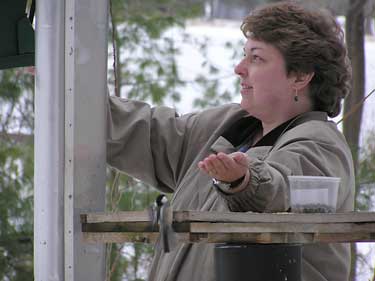Weighed down with duffel bags and suitcases, students introduce themselves to roommates while they anxiously familiarize themselves with new surroundings. The sudden influx of people triples the city’s population overnight.

But this is not Ann Arbor, Dearborn, or even Flint.
All of this activity takes place more than 200 miles north in Pellston, which becomes a hub of activity at the beginning of May when the U-M Biological Station (UMBS) opens for the season and undergraduate and graduate students, and faculty members gather to take courses and conduct research during the spring and summer months.
“This time of the year is always kind of exciting,” says Lisa Readmond, UMBS office manager since 1988. “I look forward to spring when I get to see returning people and start thinking about how camp is going to be alive again. It literally mushrooms overnight. On Friday night it’s dead and by Saturday morning there’s 300 people in camp.”
The 13,000 acres of land that comprise UMBS create a natural setting for outdoor classrooms and research laboratories. UMBS, which opened in 1909, is a small community where its citizens spend nearly 24 hours a day together, including sharing food in a communal dining hall. Dedicated to education and research in field biology and related environmental sciences, UMBS officials have a goal to produce graduates who are prepared to understand and solve environmental problems.
“One of the most important parts about being here is that it’s an educational location,” Readmond says of the area. “You can start learning outside. Insects, birds, trees, fish—everything is all around. Classes take field trips almost every day.”
Currently, Readmond and the other seven winter staff members are gearing up for the influx of students and researchers. In the winter, she sees 8-10 people around UMBS. The number jumps to 100 people in the spring, and climbs to 250 in the summer.
“It’s a ghost town right now,” Readmond says. “In the fall, it’s the same way; overnight, they’re gone,” she adds. “The wildlife, in the summer, we don’t see them. [In the fall], the next day, they’re back all over the place.”
Housing at UMBS consists of about 100 cabins, which range from very rustic—without running water or central heat—to more advanced cabins that are insulated and feature bathrooms, primarily used for research faculty.
Readmond is the primary contact for all UMBS guests. She arranges housing, takes care of billing, acts as bookstore manager, and orders all clothes, textbooks and office supplies, among other duties. Because there is only one winterized building at UMBS, she must move the administration office back and forth in camp twice a year.
As head of housing assignments, Readmond says she gets to know peoples’ names long before they arrive in camp. Readmond says some names are more difficult to decipher than others and that she’s learned a lesson—ask for gender on the housing information forms.
“One time, I had a person named Kyle,” Readmond recalls. “I assumed it was a man. Kyle came to me [after arriving] and said, ‘I can’t live here.’ She was a woman.”
Readmond says she enjoys gaining a better understanding of nature and also learning about the history of the camp. “When I walk around the classrooms on the trails I always think of the countless people that have been here before me and where they are now and how UMBS affected the rest of their lives,” she says.
For more information about UMBS and to view a list of courses and research opportunities, visit www.lsa.umich.edu/umbs.

